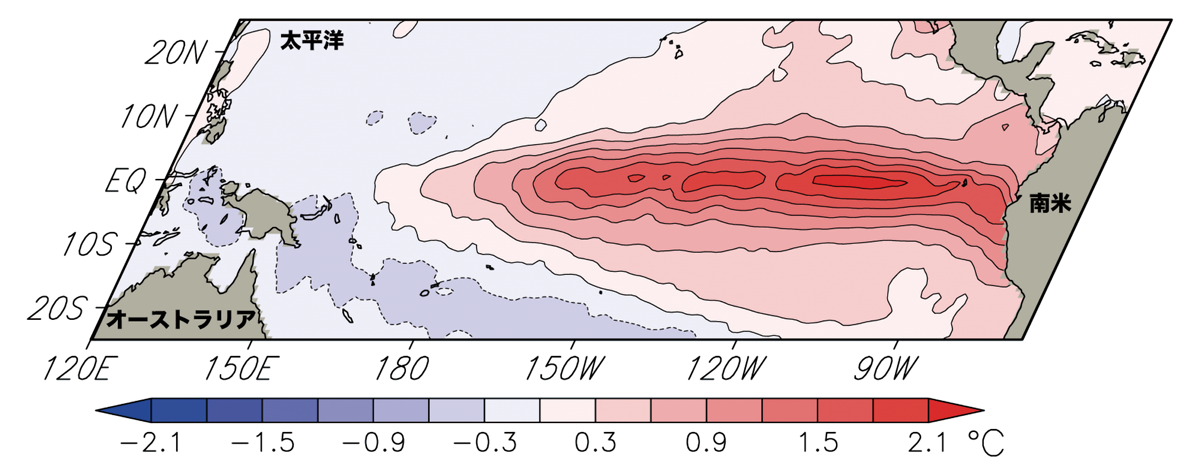Disclaimer: machine translated by DeepL which may contain errors.

Interactions Involved in El Niño Phenomena
Tomoki Higashizuka
(Associate Professor, Department of Earth and Planetary Science)
One of the reasons for this is the El Niño phenomenon that occurs in the tropical Pacific Ocean, far away from Japan. The El Niño phenomenon is a phenomenon in which sea surface temperatures off the coast of South America become warmer than normal, as shown in the figure below, and is known to cause abnormal weather throughout the world. If this phenomenon could be accurately predicted in advance, it would be possible to mitigate the effects of extreme weather events. However, the accuracy of forecasting remains a challenge because the mechanism of this phenomenon is not well understood and the climate models used for forecasting do not reproduce the El Niño phenomenon well in some areas. Various studies are still underway around the world, and I hope to unravel the mysteries of this phenomenon. It has long been known that the interaction between the atmosphere and ocean is important for the growth of El Niño events, but it is now known that there are other interactions that play an important role.
One is the interaction with turbulence. Turbulence exists in the ocean and plays an important role in the vertical mixing of seawater. Because the ocean is heated by solar radiation, it is generally warmest near the sea surface and cools as it gets deeper. Turbulence mixes the warmer water near the sea surface with the colder water below, thus cooling the area near the sea surface. Simulations of the ocean have shown how the cooling effect of turbulence changes with El Niño events and how it affects the growth of El Niño events, and for the first time it has been shown that the weakening of this cooling effect is the most important effect on the growth of El Niño events. The fact that turbulence as small as a few centimeters plays an important role in the growth of El Niño events, which can spread over thousands of kilometers, is interesting, but the mechanism of turbulence generation and variation and its reproduction in simulations await further study.

SST deviations from the normal at the peak of an El Niño event. The warmer-than-normal region is indicated by warmer-than-normal temperatures, while the colder-than-normal region is indicated by colder-than-normal temperatures.
Another area that has recently been attracting attention is the interaction with marine ecosystems. In particular, it is known that phytoplankton concentrations near the surface are high in areas where El Niño events occur because of the abundant supply of nutrients from deeper areas due to upwelling currents. However, when an El Niño event occurs, the upwelling is weakened and the supply of nutrients is suppressed, resulting in a decrease in phytoplankton. This results in a "clearer" ocean and less solar radiation absorbed near the surface, which means less warming of the near-surface layer than in normal years. In other words, it will play a role in attenuating the El Niño event. This negative feedback from phytoplankton to the El Niño event was quantitatively revealed by analyzing the results of a simulation of the ocean ecosystem. While it is interesting that phytoplankton, which is even smaller than turbulence and at most 1-2 mm in size, can influence El Niño events, the interaction with the marine ecosystem is quite complex and requires further study.


